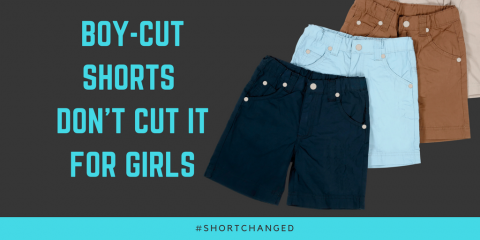
Schools are increasingly responding to calls to give girls the choice of wearing shorts and pants, or to provide gender neutral uniforms. Some schools do this by simply taking away the labels of ‘girls’ and ‘boys’ from existing uniforms and ‘ta-da!’ – gender neutral uniform. This often means these schools are actually offering the former ‘boys’ uniform – boys’ shorts and pants – to all students.
Taking away labels isn’t the answer
This doesn’t work universally for all the girls in a school. Some girls will be happy simply to wear shorts and pants, even if they are the boy version, just so they can wear shorts and pants. Their desire to wear shorts is stronger than their need to fit in and conform. Inevitably though, it comes with judgement.
Rosie had been wearing the boys’ school uniform for two years, and at 7 was regularly asked why:
“Sometimes older kids tell me I can’t wear shorts, or that they’ll tell the principal, but they never have. I’ve been asked lots of times why am I wearing the boys’ uniform when I am a girl.
Koda* experienced the same:
“While I am glad that I am now able to wear the boys’ uniform, because I am one of the few kids in the school who has actually gone through with the uniform change…I have received some backlash from other students at the school. I have been jeered at by other students and had people I’ve never met before walk past and say to their friend, ‘there’s that weirdo’.”
Offering real choice
If schools are focussing on student choice, rather than the need for a quick-fix for their uniform policies, they would select short and pant options that students want to wear. If schools offer boy shorts and pants for everyone, choose poor materials or ugly options, there’s no surprise girls don’t wear them. It’s also no surprise these schools then argue girls simply want to wear dresses and skirts. The fact is, the alternatives are unsuitable. There is no real choice.
If we switch this scenario, offering boys the ‘option’ of wearing girls’ shorts and pants, it’s easier to see why it doesn’t lead to high uptake. We still live in a heavily gendered society where there is extreme pressure to conform with a binary view of gender. GUA advocates for girls having the choice of a suitable, practical, comfortable everyday uniform. We know for girls that means having the choice of shorts and pants that fit their body type. Given the low levels of physical activity for girls, particularly in high school, we want to make sure that uniform isn’t getting in the way of girls who want to run around and play sports.
Who wears the costs?
Schools raise cost and supply issues as a reason for not moving quickly to implement shorts and pants for girls. If a school policy offers choice, some girls will always choose the skirt option – so stock will get sold. We know skirts and dresses reduce girls’ physical activity. We know that dress and skirt-only uniforms for girls are part of the everyday sexism and discrimination girls face. Schools should want to offer a genuinely unisex option; or girls shorts and pants quickly, because of the known benefits to girls. To put up barriers, financial or otherwise, forces girls to wear the cost.
Shortchanged
Lots of schools do offer the full range of uniform options to their students, with styles and fit to suit everyone. It’s definitely possible and easy to do relatively quickly, even if it means focussing just on a colour for pants and shorts, with students having the choice of style. Not having shorts and pants for girls means that girls are being shortchanged. Their everyday uniform is not one that is practical, comfortable, allowing them to focus on their learning. Schools need to consult with girls on the style of pants and shorts they want to wear. And another thing, everyone needs pockets – let’s not short-change girls on that.
*named changed
